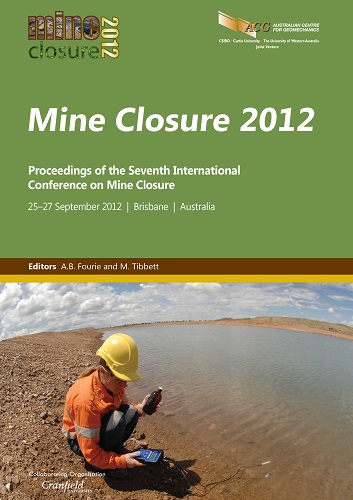Using laboratory and in situ data to develop a tailings cover design model

|
Authors: Chapman, PJ; Williams, DJ |
DOI https://doi.org/10.36487/ACG_rep/1208_33_Chapman
Cite As:
Chapman, PJ & Williams, DJ 2012, 'Using laboratory and in situ data to develop a tailings cover design model', in AB Fourie & M Tibbett (eds), Mine Closure 2012: Proceedings of the Seventh International Conference on Mine Closure, Australian Centre for Geomechanics, Perth, pp. 365-378, https://doi.org/10.36487/ACG_rep/1208_33_Chapman
Abstract:
Developing models that mimic real world conditions is challenging. In many cases, data to suitably quantify the behaviour of the materials in question are unavailable to the designer, and assumptions must be made. This can lead to an overly conservative model, which in turn results in conservative and most likely more expensive solutions. This is of particular of relevance to the closure of tailings storage facilities, where costs can increase significantly from estimates made during project initiation and operations. In arid Western Australia, in situ moisture content and matric suction measurements of the desiccation and re-saturation cycles of sulphide nickel tailings have been collected over a period of about two years. A laboratory column experiment has also been carried out to mimic the deposition and drying cycles and provide additional data, under controlled conditions, to estimate the ponding depth required to infiltrate through the full depth of desiccated tailings. These data were used as a basis to develop a preliminary cover design model, in which the desiccated tailings are incorporated into a store and release cover system, minimising the need for additional cover materials and resulting in a significant economic saving to the mine. The key outcomes of the preliminary model are presented, along with a general description of the parameters required to develop similar models.
References:
Allen, R.G., Pereira, L.S., Raes, D. and Smith, M. (1998) FAO Irrigation and Drainage Paper No. 56 – Crop Evapotranspiration.
ANCOLD (2011) Australian National Committee on Large Dams. Guidelines on Tailings Dams, Planning, Design, Construction, Operation and Closure, Australian National Committee on Large Dams, May 2012.
Campbell Scientific Inc. (2009) 229 Heat Dissipation Matric Water Potential Sensor, Revision 5/09.
Campbell Scientific Inc. (2010) CS215 Temperature and Relative Humidity Probe, Revision 10/10.
Chapman, P.J., Williams, D.J., Rohde, T. and Ennor, S.J. (2008) Understanding the Water Balance of Potentially Acid Forming Tailings Deposited in a Dry Climate, in Proceedings Third International Seminar on Mine Closure (Mine Closure 2008), A.B. Fourie and M. Tibbett, I.M. Weiersbye, P. Dye (eds), 14–17 October 2008, Johannesburg, South Africa, Australian Centre for Geomechanics, Perth, pp. 400–409.
Chapman, P.J., Williams, D.J. and Rohde, T. (2009) Unsaturated Behaviour of Tailings during Deposition and Desiccation Cycles with Reference to Closure Design, in Proceedings of Fourth Asia Pacific Conference on Unsaturated Soils (UNSAT2009), Newcastle, Australia, 23–25 November 2009, pp. 477–482, CRC Press/Balkema, The Netherlands.
Fredlund, M.D., Fredlund, D.G. and Wilson, G.W. (1997) Prediction of the soil water characteristic curve from grain size distribution and volume mass properties, in Proceedings of Third Brazilian Symposium on Unsaturated Soils, Rio de Janeiro, Brazil,
22–25 April 1997, 12 p.
Fredlund, D.G., Xing, A. and Huang, S. (1994) Equations for the soil-water characteristic curve, Canadian Geotechnical Journal, Vol. 31, No. 3, pp. 521–532.
INAP (2009) The International Network for Acid Prevention. Global Acid Rock Drainage Guide (GARD Guide), .
Qian, X., Koerner, R.M. and Gray, D.H. (2002) Geotechnical Aspects of Landfill Design and Construction, New Jersey: Prentice Hall, Upper Saddle River.
UNEP (1992) United Nations Environment Programme. World Atlas of Desertification.
© Copyright 2026, Australian Centre for Geomechanics (ACG), The University of Western Australia. All rights reserved.
View copyright/legal information
Please direct any queries or error reports to repository-acg@uwa.edu.au
View copyright/legal information
Please direct any queries or error reports to repository-acg@uwa.edu.au